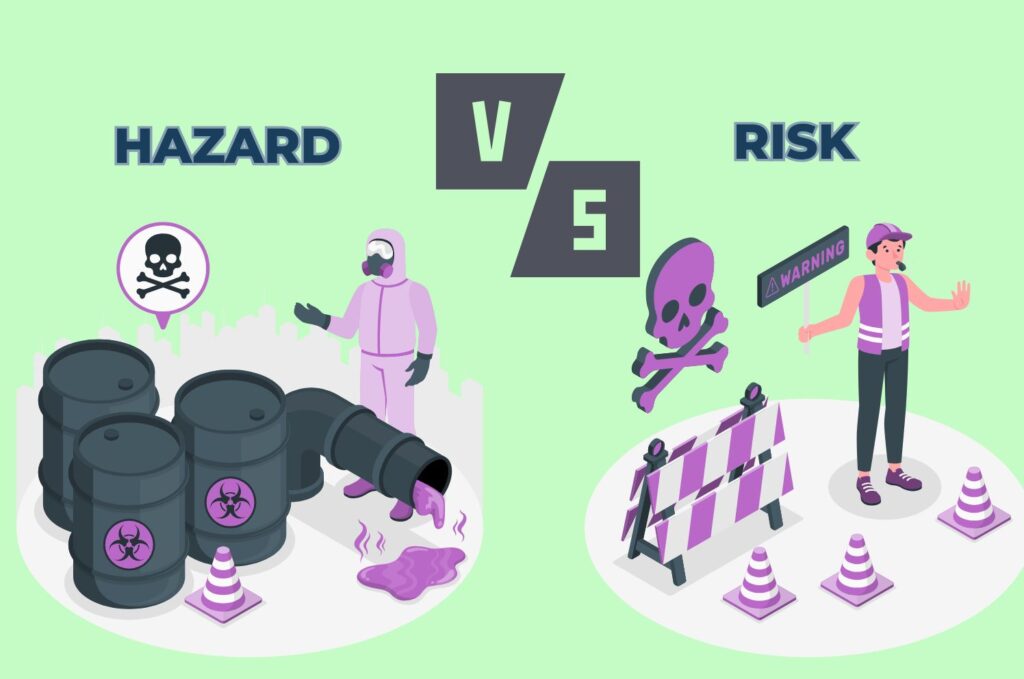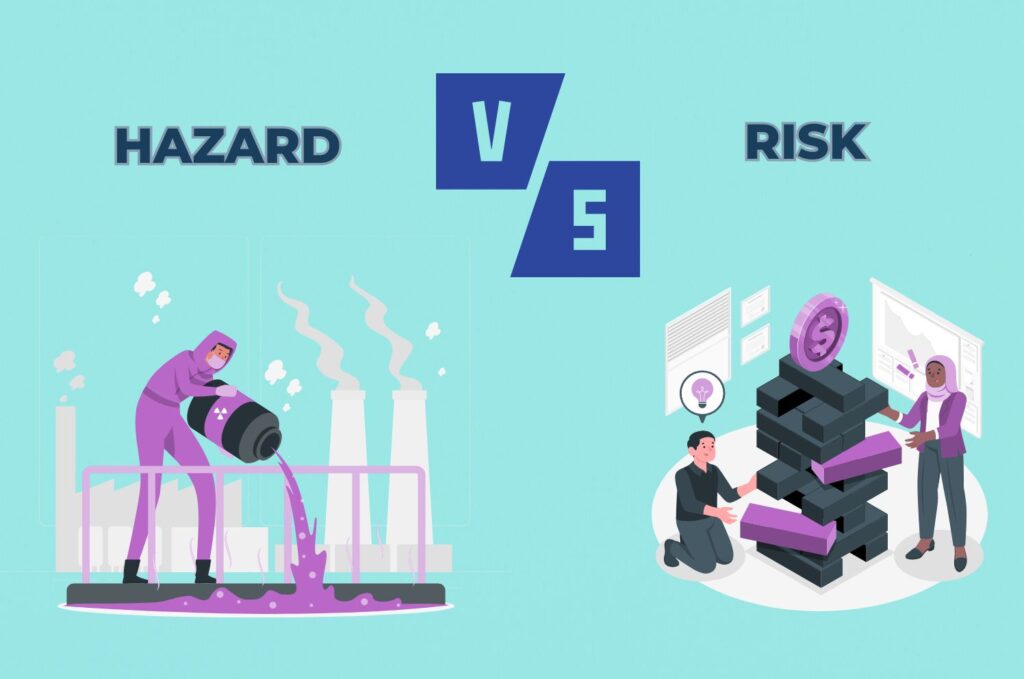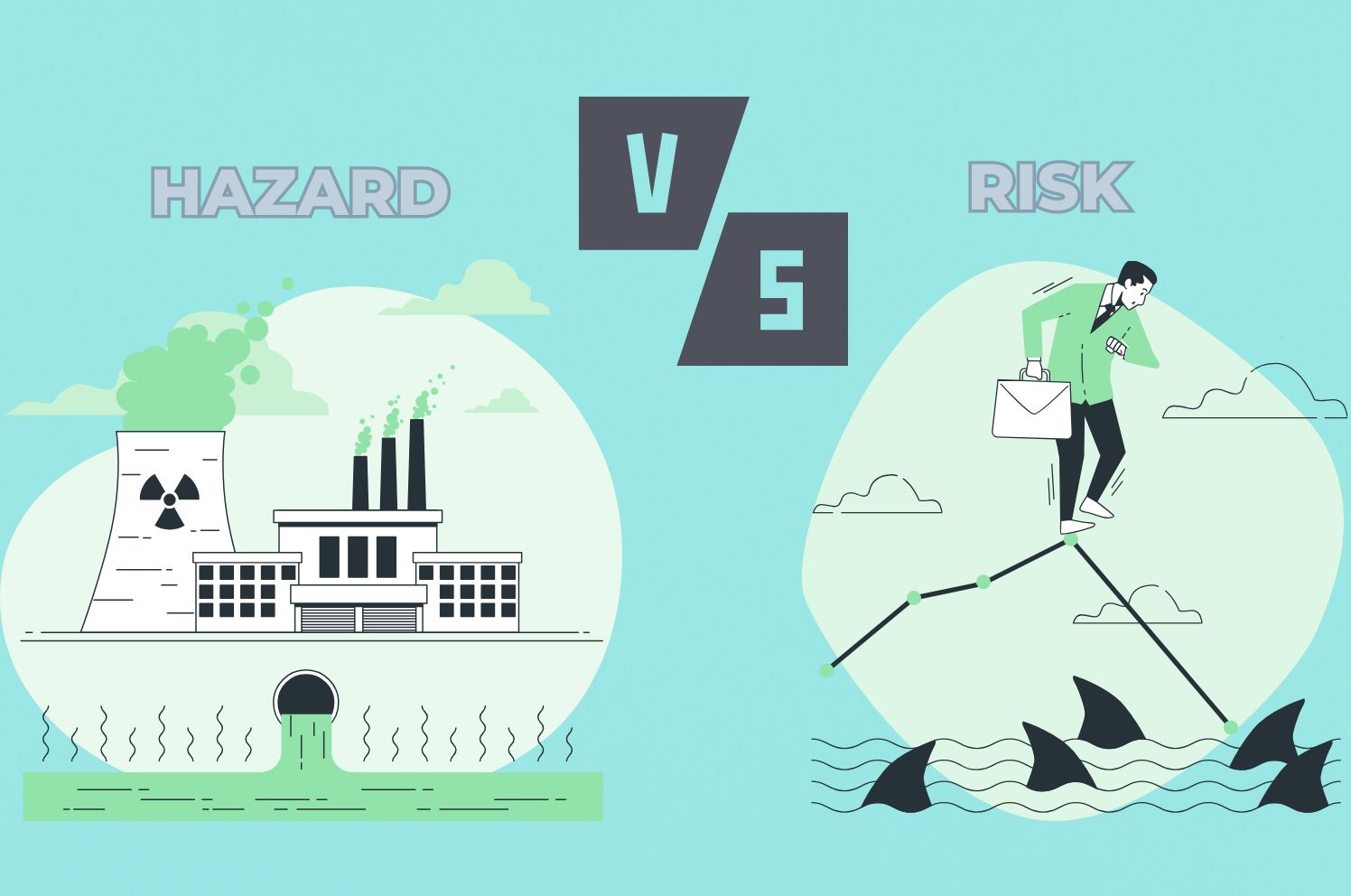When planning and implementing meaningful safety functions, it is important to emphasise the grave difference between hazards and risks. Today’s blog covers 10 critical variations between hazards and risks and how these differences can help you improve your safety protocols. To get the most out of this blog, grab your preferred choice of beverage and start reading right now.
1. Difference Between Hazards and Risks in Definitions
What Constitutes a Hazard?
A hazard is any substance or situation that could cause harm to a person or persons. This includes a source or agent that has the potential to cause harm or adverse health effects on a person or persons; an activity, condition, or situation that could cause injury, illness, or property damage. A hazard resulting from a release or threat of release of hazardous materials into the environment.A pesticide product that has been applied in a manner that violates its manufacturer’s instructions.
Examples of Common Hazards
Medication, electricity, machinery with moving parts, bad back postures that cause repetitive strain, and viruses and bacteria are hazards.
What Constitutes a Risk?
Risk is the chance or likelihood that a person will be harmed or have an adverse health effect if exposed to a hazard. Risk can also be stated in terms of the severity of the harm.
Examples of How Risks Are Calculated
Risk involves both likelihood and severity: the probability that something will go wrong, and the magnitude of the resulting harm. For instance, determining the risk that additives in breakfast cereal will cause health problems requires working out both how likely it is that someone will consume the cereal, and how severe the health problems will be if someone does.
2. Context-Dependent Nature
Nature of Hazards
Hazards exist independently of persons; the toxic chemical in the lab is a hazard no matter whether it sits in a rack or spills on the floor. Examples of innate hazards are the toxicity of a chemical or the sharp corners of a machine.
Nature of Risk
Risk is exposure-dependent – in other words, risk arises from the setting, not from a one-size-fits-all phenomenon. The risk depends on how individuals encounter a hazard in their surroundings. The same hazard can give rise to different levels of risk in different settings.
How Risks Depend on the Interaction Between Hazards and Exposure
Risk is the product of hazard and exposure. The risk of being electrocuted, for example, comes from the hazard posed by an exposed wire and the exposure we have to it.
3. Methods for Identifying and Assessing
How to Identifying and Assessing Risks
Hazards can be identified by conducting workplace inspections, safety audits, investigating incidents, and reviewing safety data sheets (SDS).
Tools and Techniques Used in Hazard Identification
Typical tools and techniques include checklists, hazard and operability studies (HAZOP), job safety analysis (JSA) and root cause analysis.
How to Identifying and Assessing Risks
Risk identification is about recognising hazards, as well as the likelihood of their impacts and their consequence may look like. Techniques include risk matrixes, failure mode and effects analysis (FMEA), and risk assessments.
Tools and Techniques Used in Risk Assessment
Some common tools for micro-identifying and micro-assessing risks include risk-assessment matrices, quantitative risk assessment (the practice of applying a measure to describe risk based on probability and exposure to risk and impact severities), and software-based risk-management tools.

4. Qualitative Measurement
How to Measure Hazards
Qualitative measurement classifies hazards based on their nature and potential to cause harm – by identifying type and classifying properties.
Examples of How Hazards Are Described
An example could be a chemical’s description as flammable, corrosive or toxic. Machinery might include equipment with sharp edges or moving components that could lead to injuries. A biological hazard could be infected agents or pathogens such as bacteria or viruses.
How to take Measure of Risks
These are quantified risks, informed by a couple of numeric values: the probability of an event occurring; and its possible consequences.
Risk Assessment Formulas and Their Application
In terms of numbers, we generally estimate risk with a formula: Risk = Likelihood x Severity. That way, we can assign a more specific numerical value to the risk level, making it easier to allocate efforts toward prevention and mitigation. The probability of a fire occurring in a chemical plant can be estimated. So can the potential damage to equipment or lives.
5. Potential Impact
Hazards Without Considering Exposure
A hazard is how dangerous a hazardous materials or condition is in its own right, irrespective of whether people experience it (as in the case of the deadly chemical, which would cause serious health problems even if no one handled it). And yet, our aversion to danger responds primarily to factors that relate to risk rather than hazard.
Examples of Hazardous Materials or Conditions
Others might be toxic substances, such as asbestos causing lung disease by inhalation, or heavy machinery that can cause serious bodily injury when inadequate safety protocols are in place.
Impact of Risks, Considering Likelihood and Severity
Assessment of risk involves considering the combination of both the likelihood of exposure – the probability of exposure – and the level of harm that results from the exposure. For instance, a deteriorating building with insulation will entail a much greater risk of asbestos exposure than will a new building meticulously maintained and not yet in need of any renovations.
Case Studies Illustrating Risk Impact
For instance, a case study might be a factory where the risk of chemical spills must be determined. If the factory has robust safety protocols and few actual spills, the risk will be low. A factory with poor safety protocols and frequent spills is at high risk.

6. Strategies for Elimination or Reduction
Control Measures for Hazard
Strategy focuses on eliminating, or at least minimising the source of the hazard. This could mean replacing hazardous materials with safer substitutes, redesigning equipment to make it safer to use, or removing hazardous materials entirely.
Engineering and Administrative Controls
Engineering controls, for example, address an issue by making physical changes to the environment, by adding a guard to a machine or by installing exhaust fans or ventilation systems. Administrative controls include anything that falls under training employees, establishing protocols, fixing safety issues or conducting safety walks or safety audits.
Strategies for Risk Management and Mitigation
Risk management consists of assessing, evaluating and prioritising risk factors, following an action designed to limit the possibility of exposure or mitigate its implications.
Personal Protective Equipment (PPE) and Other Risk Controls
These controls would include PPE such as gloves, safety helmets and respirators to protect workers against particular risks. Other controls might include safety signage, emergency procedures, routine maintenance checks on all equipment to ensure that it is working properly and safely, etc.
7. How Hazards and Risks Are Perceived
Hazards Perceived by Different Stakeholders
But stakeholders may hold different perceptions of hazards, depending on the way they are exposed to them. A worker is familiar with the hazards of machinery in the workplace, for example, where management might perceive them only as financial implications of safety protocols.
Factors Influencing Hazards Perception
These include own (having lived through) and vicarious (hearing others’ tactics); exposure (level of training); visible (eg, more visible hazards, like heavy machinery, are perceived as more dangerous than less visible ones, like chemical vapours); and culturally related dimensions.
Risks Perceived by Different Stakeholders
Both of these risk definitions make intuitive sense. One group of stakeholders, for example, might be particularly concerned with worker safety, while another group (managers, for instance) might have a narrower focus on the continuity of operations or regulatory compliance.
Factors Influencing Risk Perception
Factors include the memory of past incidents, the prominence of news coverage, personal beliefs about the risk of an event, and whether an individual believes that they have control over the risk being taken. For instance, employees might consider a risk to be low if they believe the appropriate safety measures are within their control.
8. Examples in Various Industries
Real-World Scenarios Showcasing Hazards
In the chemical industry, we may, for instance, come across toxic substances or flammable chemicals as hazards, whereas in construction we can have falling objects or heavy machinery as hazards.
A chemical plant that leaks from its storage tanks potentially creates an exposure scenario to toxic chemical exposure. A construction site that lacks guardrails on its scaffolding provides a fall hazard.
Real-World Scenarios Showcasing Risks
For instance, risks in the financial sector are market volatility and credit risks, whereas risks in the healthcare sector are patient safety risks and medical error risks.
A financial firm heavily investing in choppy markets is at high financial risk. A hospital with low hygiene practices is at risk of healthcare-associated infections.
Laws and Regulations Related to Hazards Identification and Management
Legislation such as the Control of Substances Hazardous to Health (COSHH) in the UK demands that all hazardous materials are listed and controlled.

9. Key Regulatory Frameworks
Laws and Regulations Related to Hazard Identification and Management
Legislation such as the Control of Substances Hazardous to Health (COSHH) in the UK demands that all hazardous materials are listed and controlled.
Chief bodies are the Health and Safety Executive (HSE) in the UK and similar bodies in other countries, which enforce occupational health and safety (ie, workplace safety) regulations and also publish guides on the management of hazards.
Laws and Regulations Related to Risk Assessment and Management
Risk assessment and controls to mitigate risk are required through regulations such as the Management of Health and Safety at Work Regulations (MHSWR).
isk management practices and compliance, for example, are governed by regulatory bodies such as the Financial Conduct Authority (FCA) in the financial sector and the Care Quality Commission in healthcare (CQC).
10. Best Practices for Communicating
Tools for Hazard Communication
Communication about risk needs to be succinct, clear language that’s shared in training sessions, safety briefs and written materials.
The tools include the ‘stop’ signs and labels on the chemical products, Safety Data Sheets (SDS) and symbols that communicate the nature of the hazards and the precautions needed.
Tools for Risk Communication
Risk communication involves transparency and candour, with familiar language and context, and updates and risk briefings from the project.
Risk may be communicated with tools like risk matrices and reports depicting likelihood, impact or other factors, or even using dashboards that illustrate risk levels. Regular meetings and workshops are another way of promoting risk communication.
Conclusion
Hazards and risks are two terms that are often confused and conflated, but understanding their main differences is key to being effective in accident prevention and overall management. While hazards are potentially harmful circumstances or situations that may exist in our working environments, risks are the combination of probability of occurrence and severity in dealing with that hazardous circumstance or situation. Knowing how to recognise and deal with both hazards and risks is fundamental to ensuring safe work practices and environments. Use good hazard and risk management practices in your organisation to help keep your team out of trouble and enforce safety regulations.

